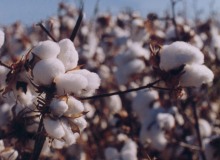Researcher: Chicken litter in cotton production

Chicken litter is much more valuable as a fertilizer than previously thought, according to an Agricultural Research Service (ARS) study showing its newfound advantages over conventional fertilizers.
Litter is a mixture of chicken manure and sawdust or other bedding material. Some cotton farmers in the Mississippi area are switching to chicken litter and away from standard inorganic, synthetic fertilizers. Many other farmers are interested in the possible economic benefits of using chicken litter, but are reluctant to switch without the numbers to back up their decision, says the ARS.
Now a study by ARS agronomist Haile Tewolde at the agency’s Genetics and Precision Agriculture Research Unit (GPARU) at Mississippi State, Miss., and cooperators has provided those numbers. Tewolde did the research with GPARU soil scientist Ardeshir Adeli, 2 Mississippi State University colleagues, and Karamat Sistani, research leader at the ARS Animal Waste Management Research Unit in Bowling Green, Ky.
Previous studies only considered the economic value of the nitrogen, phosphorus and potassium in chicken litter, compared to that in synthetic fertilizers. Farmers know that chicken litter, an organic fertilizer, is a better soil conditioner than synthetic fertilizers, but have never had a way to assign a number to the value of that benefit.
In their study, Tewolde and colleagues figured the litter’s value as a soil conditioner as an extra US$17/t litter. They calculated this by balancing the price tag of the nutrients in litter with its resulting higher yields, a reflection of its soil conditioning benefits.
They found that cotton yields peaked 12% higher with organic fertilizers, compared to peak yields with synthetic fertilizers. With all benefits factored in, they found that chicken litter has a value of about US$78/t, compared to US$61/t when figured by the traditional method.
The economic analyses also showed that farmers could further increase their profits by using less of either fertilizer than currently used for maximum yields, which is also good news for the environment.
This research was published in the Agronomy Journal.
Source: Agricultural Research Service













